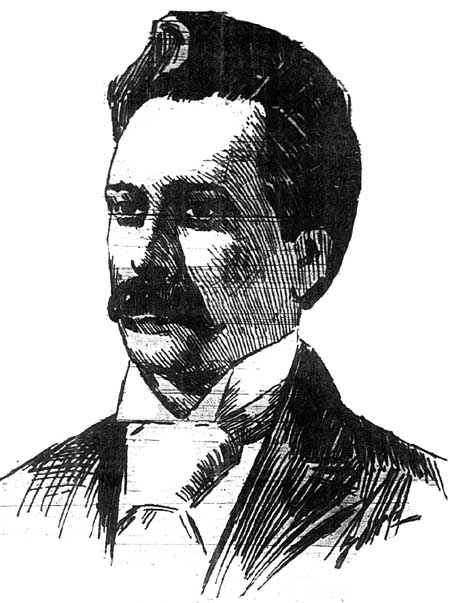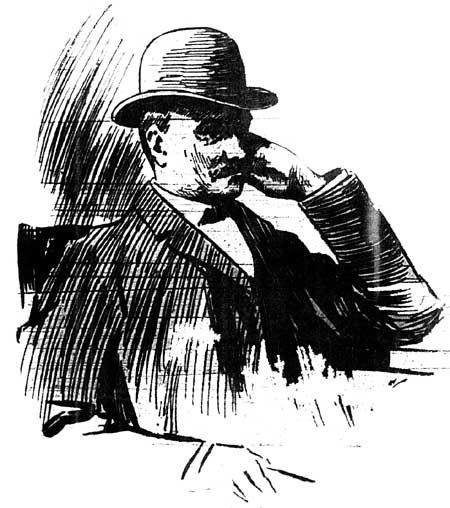
READ CHAPTER 1
GALLERY
WHO'S WHO
ATLAS
MYTHS DEBUNKED
FAMILY TREE
CONTACT THE AUTHOR
UPCOMING EVENTS
REVIEWS
CHICAGO HISTORY LINKS
READING SUGGESTIONS
BUY THIS BOOK
The Body-Snatchers at Dunning
Alchemy of Bones tells of a possible link between the Luetgert murder case and a body-snatching case at Dunning, the Cook County insane asylum. The following is a more detailed account of the morgue thefts.
John Humpel looked as if he had been bruised and cut. His wife, Louise, was surprised to see how scraped-up he was when she visited him at Dunning, the Cook County insane asylum, in late October 1897. He had been admitted to the asylum four months earlier with a case of "acute mania," but he was usually in good physical health.
"An attendant closed the door of the ward in my face until a cloth could be thrown over my husband’s features and he could be turned over on his face," Mrs. Humpel later recalled. "I noticed something was wrong with him, for there was not a more robust patient in Dunning than he, and asked them to let me see his face. The attendant refused and would not let me come near enough to the bed to touch my husband. From his mutterings, though, I learned he had just been beaten."
Mrs. Humpel contacted a lawyer, hoping to investigate how the institution was treating her husband. But the following day, she received word that her spouse had died of consumption.
Her lawyer told Dunning officials that the family wished to conduct a post-mortem examination of the body. However, a day later, Mrs. Humpel heard that the body of her husband and three other corpses had disappeared from the morgue on the asylum grounds. The four missing bodies had belonged to Humpel, 34; Annie C. Johnson, 51;
Frank Gray; and Dominick Marcus.The morgue was a one-story red-brick structure about twenty feet square, with two small windows and a single, heavy door, standing at the edge of the institution’s grounds, near a low whitewashed fence, a cornfield, and a seldom-traveled "blind road." Inside, the bodies of deceased Dunning inmates were placed in tiers, with a tag on each coffin telling the history of the corpse within. The bodies were covered with a white shroud and kept packed in ice for five days, until the county had advertised the death. If no one claimed the bodies, they were buried in the potter’s field or turned over to the Demonstrators’ Association, which distributed them among the medical colleges for anatomy classes.
A poorhouse resident who had been entrusted with watching over the morgue found the padlock removed from the building on the morning of October 27, 1897. He went in and discovered that all twelve coffins had been disturbed during the night. The shrouds had been torn open, and there were signs that someone had rummaged around inside each box. Four of the coffins lay on the floor, emptied of their bodies and shrouds. The old man ran out of the morgue and alerted the guards.
Mrs. Humpel accused the county of removing her husband’s body from the morgue to cover up evidence that he had been mistreated or even killed at Dunning, but a hearing turned up no evidence to support that theory. Officials did, however, suspend a night watchman, Henry Ulrich, for being neglectful on the night the bodies were stolen.
In December, police arrested drayman John Ludes and then, after a two-week manhunt, Ulrich. Under questioning by Cook County Board President Daniel Healy himself, the two men confessed to taking the bodies. Ulrich said two doctors had paid him for the cadavers, and he had hired Ludes to drive the bodies out of Dunning in his wagon under the dark of night. Ulrich and Ludes had then looked on, pale-faced, as the doctors emptied jugs of embalming fluid into the arteries of the bodies at a remote cabin. Ludes delivered the bodies in trunks the next day at a train station, where the doctors picked them up on their way out of town. The police department also fired Officer William Stine on the charge that he had helped to organize the body-snatching scheme, a charge that Stine denied.
Ulrich and Ludes were initially charged only with stealing the four sheets that had covered the bodies, but a grand jury was preparing to bring more serious charges. Authorities also called for the extradition of Dr. William Smith of Kirksville, Missouri, the professor who had taken possession of the bodies, who was back in his home state with his stolen goods.

Before rummaging through the coffins and selecting the best bodies, Smith said he had told the watchman, "Now, Ulrich, there is one thing I wish understood. I am not wanting to take any body which may be desired by relatives. They have the right to them."
"After these bodies have lain in the morgue the legal five days," Ulrich said, according to Smith, "the day following they are taken out in the potter’s field and ‘terraced up’ if no one has claimed them. That night, likely, every one of them will be lifted for commerce. You see, it’s this way: The undertaker gets $55 a month. He wears diamonds as big as your thumb and drives fast horses — do you see? — and he don’t pay for these luxuries burying paupers at $2.95 apiece. In case there is a sale before burial, as in your case, doctor, we just fill the coffin with ice and let it go to the grave in lieu of the pauper clay — the city would just as soon pay for one sort of funeral as another. When the undertaker comes on a case with nothing but ice left in the coffin he knows it — mind — it isn’t just the same heft exactly, so he says to himself, ‘Hank has been having some trade,’ and he lets it go at that."
Smith claimed that Ulrich then offered to procure a living patient for his anatomy demonstrations.
"What can you do with a freak, doctor?" Ulrich asked, according to Smith. "We have one in the asylum, and I can get him for you."
"What kind of a freak is it?" Smith replied.
"It is a man or a woman — blamed if I know what to call it —
which has been on exhibition in the city museums as the ‘bear man.’ It went daffy over a Circassian beauty or a snake charmer, I forget which, is a real fancy freak, with six fingers on each hand, and can walk on all fours. If you’ll take it you can have it for $50.""Why, he’s still living, if he’s in the asylum
— I only want the dead ones.""That’s all right, doc, just say you’ll give me the fifty and you can take him in one of those trunks. He’s in the ‘killer ward’ and they’d just think he’d wandered off
— they’re always doing that, you know."Smith recalled that he had been dumbfounded as he responded, "I want it understood distinctly I am not in on any such deal."
"If there’s none here that suits you just come around tomorrow and go through the wards and point out the ones you want," Ulrich allegedly told him. "You can get them by tomorrow night."
Smith did not take up Ulrich on this offer, but he and an assistant did select four bodies they wanted in the morgue.
In his article, Smith leveled a series of accusations against Cook County officials. He demanded Board President Healy’s answer on whether Dunning truly had a "killing ward." Smith also said he had examined the body of John Humpel and disputed the finding that the man had died of consumption.
"If he died of consumption, I will eat the body," Smith said. "The body is that of a big, strong, robust man, weighs 175 pounds, and shows unmistakable marks of hard treatment."

Healy and Dunning Superintendent Lange (pictured) both denied the existence of a "killer ward," saying they’d never even heard the phrase used as a joke. They called Smith’s tale a "pipe dream" and too "silly" to merit a response.
County officials said the only reason Humpel’s body had marks on it was he had become violent in the last days of his life, forcing the doctors to restrain him with wristlets and anklets.
Lange acknowledged that Smith’s story had included some details about Dunning that most outsiders wouldn’t know, but he attempted to explain it away.
"How did he know there was a ‘bear man’ in the institution?" Lange said. "Why, easy enough. Everybody around here knows about ‘Dave, the museum freak,’ and his infatuation for the Circassian beauty. He is talked about a lot and it would be easy to hear of him from anybody."
Later in January, Dr. Smith testified in an unrelated court case in Missouri and admitted his story in the Times-Herald had been less than accurate.
A lawyer asked him, "Is it your opinion that a man is justified in telling a falsehood to accomplish his purpose?"
"Yes... I do not believe in a man lying for personal or private ends, but where such a course only can expose fraud and wrong doing, I am willing to lie like a dog for the benefit of the public good."
The lawyer handed him a copy of his Times-Herald article and asked, "Are you the author of that?"
"No," Smith answered.
"Did you write it?"
"I didn’t write it."
"Did you give that interview?"
"I did not make the statement contained in that interview," Smith said.
Cook County officials never got the chance to bring Smith into court. The governor of Missouri refused to extradite him, saying the charge of stealing sheets was trivial. Ulrich and Ludes were found guilty on that charge and sent to jail.
© 2003 by Robert Loerzel.
Pictures: Smith, Chicago Times-Herald, Jan. 10, 1898; Lange, Chicago Times-Herald, Jan. 10, 1898.
To find out more about the possible link between the Dunning body-snatchings and the Luetgert murder case, read Alchemy of Bones.
Sources
Louise Humpel’s comments: Chicago Journal, Oct. 28, 1897.
Morgue thefts: Chicago Journal, Oct. 25 and 28; Chicago Tribune, Oct. 25;
Chicago
Inter Ocean, Oct. 26.
Arrest of Ulrich and Ludes: Chicago Inter Ocean, Dec. 6; Chicago Journal, Dec.
19 and 22.
Dr. Smith’s statement and the reactions to it: Chicago Times-Herald, Jan. 9
and 10, 1898; Chicago Tribune, Jan. 10 and 11.
Dr. Smith testifies in Missouri: Chicago Inter Ocean, Jan. 15.
Missouri refuses to extradite: Chicago Journal, Jan. 12.